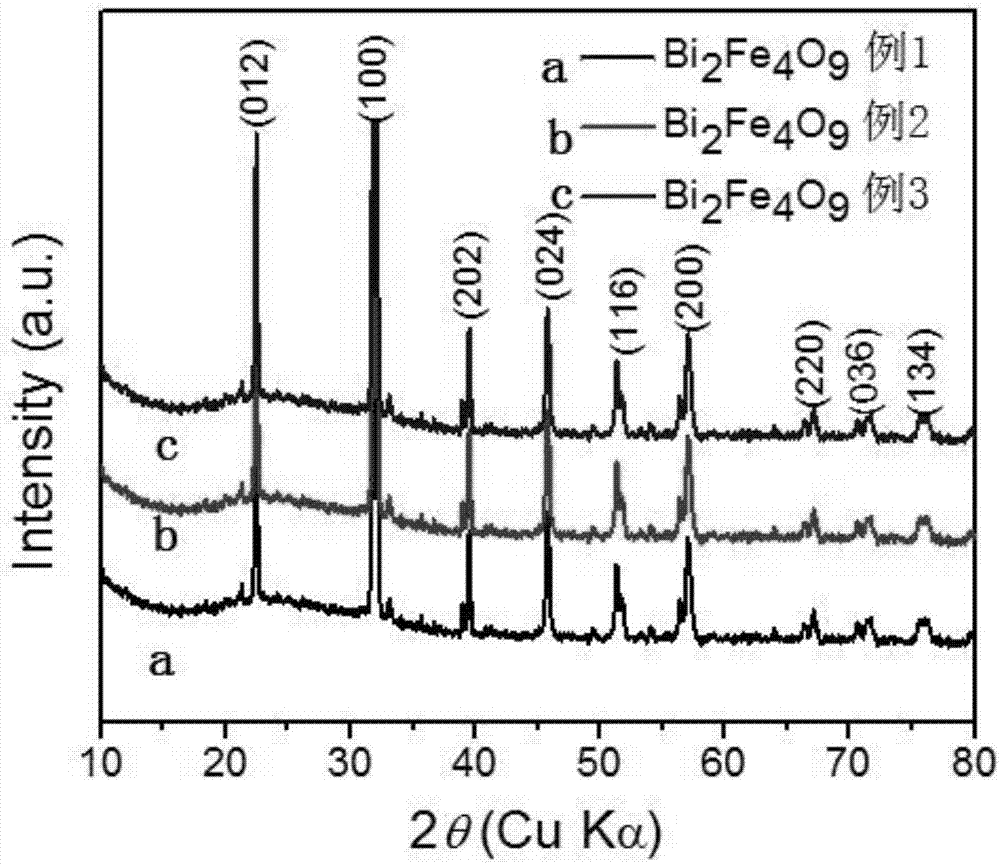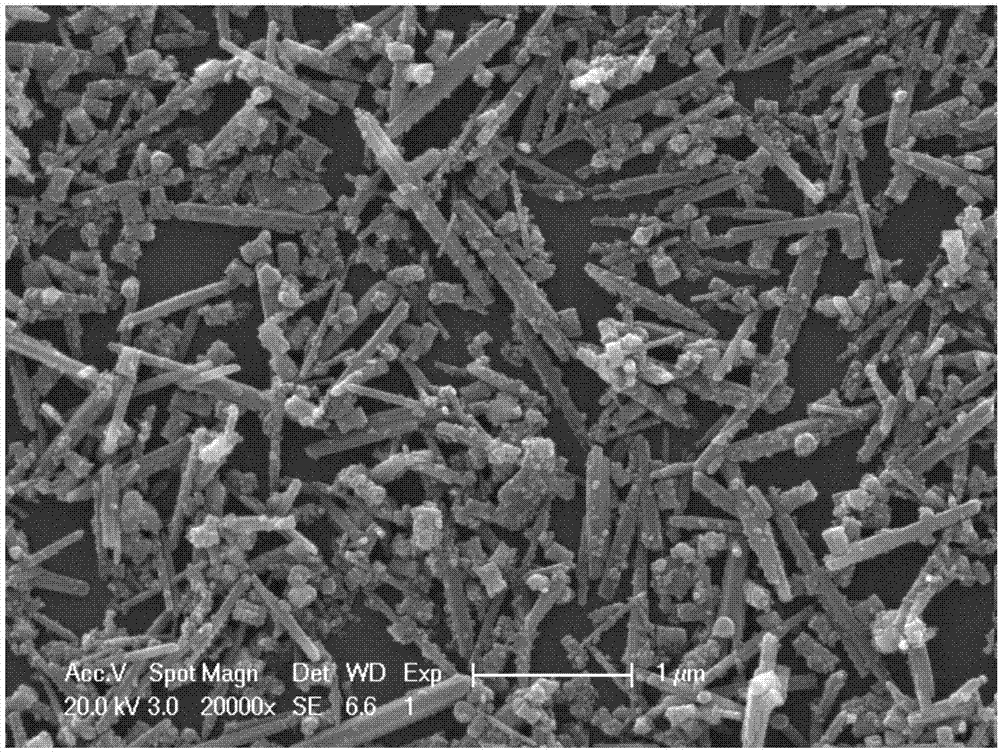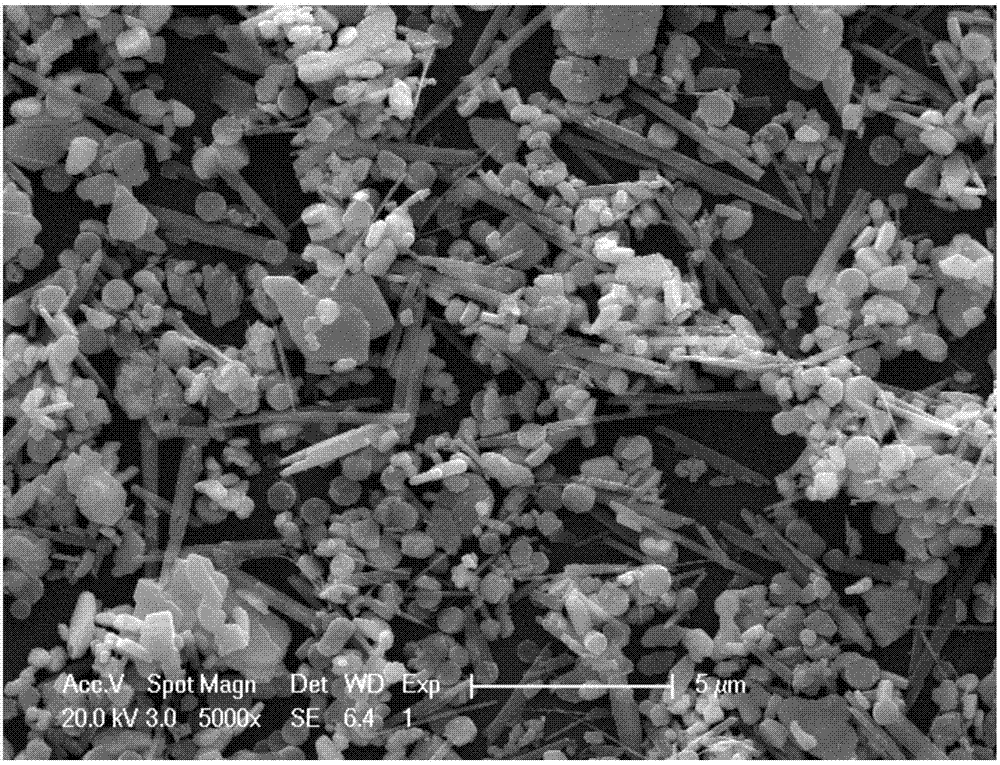Preparation method of Bi2Fe4O9 nano-rod-shaped or nano-cake-shaped material
A bi2fe4o9 and nano-cake technology, applied in chemical instruments and methods, inorganic chemistry, iron compounds, etc., can solve problems such as lack of in-depth research, and achieve the effects of good reproducibility, easy mass production and simple process
- Summary
- Abstract
- Description
- Claims
- Application Information
AI Technical Summary
Problems solved by technology
Method used
Image
Examples
example 1
[0025] 3mmol of bismuth acetate pentahydrate, 6mmol of ferric nitrate nonahydrate and 42mmol of sodium hydroxide powder were added to 35ml of distilled water, placed in a 50ml beaker, and placed in an ultrasonic instrument for 3 minutes of sonication. Pour the above solution into a 50ml polytetrafluoroethylene-lined reaction kettle, seal it, place it in an oven, control the temperature of the oven at 160°C, react for 24 hours, cool to room temperature, wash it several times, and dry it in vacuum to obtain Bi 2 Fe 4 o 9 nanorod material;
[0026] figure 1 The positions and relative intensities of each diffraction peak in the 2 Fe 4 o 9 The JPCDS card (71-2494) is consistent, indicating that the product Bi 2 Fe 4 o 9 It is highly crystalline.
[0027] from figure 2 It can be seen that the prepared Bi 2 Fe 4 o 9 Nanomaterials are nanorods with regular shape and relatively uniform size, with a length of 1-2 μm and a width of 150 nm.
Embodiment 2
[0029] Add 3mmol of bismuth chloride, 6mmol of ferric chloride and 50mmol of sodium hydroxide powder into 35ml of distilled water, place it in a 50ml beaker, and put it into an ultrasonic instrument for 5 minutes of sonication. Pour the above solution into a 50ml polytetrafluoroethylene-lined reaction kettle, seal it, place it in an oven, control the temperature of the oven at 200°C, react for 24 hours, cool to room temperature, wash it several times, and dry it in vacuum to obtain Bi 2 Fe 4 o 9 Nanorod and nanocake materials;
[0030] from figure 1 It can be seen that the positions and relative intensities of each diffraction peak are related to Bi 2 Fe 4 o 9 The JPCDS card (71-2494) is consistent, indicating that the product Bi 2 Fe 4 o 9 It is highly crystalline.
[0031] from image 3 It can be seen that the prepared Bi 2 Fe 4 o 9 Nanomaterials are composed of nanorods and nanocakes with regular shape and relatively uniform size. Among them, the length of the...
Embodiment 3
[0033] Add 3mmol of bismuth acetate pentahydrate, 6mmol of ferric nitrate nonahydrate and 60mmol of sodium hydroxide powder into 35ml of distilled water, place it in a 50ml beaker, and put it into an ultrasonic instrument for 5 minutes of sonication. Pour the above solution into a 50ml polytetrafluoroethylene-lined reaction kettle, seal it, place it in an oven, control the temperature of the oven at 200°C, react for 24 hours, cool to room temperature, wash it several times, and dry it in vacuum to obtain Bi2 Fe 4 o 9 nano cake material;
[0034] figure 1 The positions and relative intensities of each diffraction peak in the 2 Fe 4 o 9 The JPCDS card (71-2494) is consistent, indicating that the product Bi 2 Fe 4 o 9 It is highly crystalline.
[0035] from Figure 4 It can be seen that the prepared Bi 2 Fe 4 o 9 Nanomaterials are composed of nanocakes with regular shape and relatively uniform size, and few nanorods appear, indicating that with the increase of alkali ...
PUM
 Login to View More
Login to View More Abstract
Description
Claims
Application Information
 Login to View More
Login to View More - R&D
- Intellectual Property
- Life Sciences
- Materials
- Tech Scout
- Unparalleled Data Quality
- Higher Quality Content
- 60% Fewer Hallucinations
Browse by: Latest US Patents, China's latest patents, Technical Efficacy Thesaurus, Application Domain, Technology Topic, Popular Technical Reports.
© 2025 PatSnap. All rights reserved.Legal|Privacy policy|Modern Slavery Act Transparency Statement|Sitemap|About US| Contact US: help@patsnap.com



